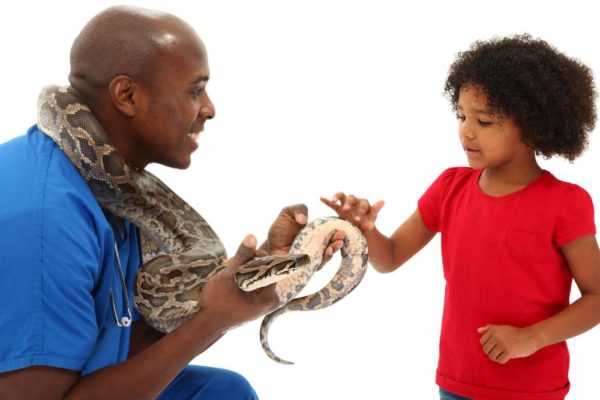Features
Adefolake Adekola: Facts about Snakes & their Place in Balancing the Environmental Ecosystem
 Snakes are long, legless reptiles that have a highly developed sense of sight, taste, touch and sound. They are highly mobile and some snakes have venoms that are lethal.
Snakes are long, legless reptiles that have a highly developed sense of sight, taste, touch and sound. They are highly mobile and some snakes have venoms that are lethal.
According to the Department of Environment and Heritage Protection of Queensland Government, there are more than 2,600 species of snakes, but some species are more predominant than others. The presence of snakes combat the problem of pest in the environment such as brown rats. Brown rats which originated from Asia have spread to different parts of the world. A pair of brown rats can have up to one million descendants in 18 months; this number is very alarming. Cape Snake Conservation believes the venom from snakes is medicinal, as it is said to reduce high blood pressure, heart fibrosis and protect the kidney. It may also be the long awaited cure for cancer.
Earlier in November, reports came that 250 people died in Gombe and Plateau states as a result of snakebites. An average of 50 victims sort treatment daily and about six of them died every day. It is not uncommon that people have died from snakebites in Nigeria over the past decades, but this brought its own uniqueness, as the number of people involved created a nationwide scare.
The common assumption is that snakes are a menace to humans but this is far from it. In Northern Nigeria, several snakebite incidences have been reported. It is very likely that there was confrontation on the part of the human. Some snakes clash with farmers in yam barns because they are there to eat pest such as rats and the rats are there for the yam tubers. That is a food chain cycle, which is the sequence of events in an ecosystem where an organism eats another and it is being eaten by another. It is only natural that snakes are looking for food and at some point they become food. The problem now is why they attack us? It is believed that when farmers are clearing their farmlands, they encounter snakes which instinct tells them to attack.
| S/N
|
MYTH | FACT |
| 1 | They threaten humans | When left alone, they present little or no danger to humans |
| 2 | They are irrelevant to humans | They bring about biodiversity and maintain a balance in the ecosystem via food chain. |
| 3 | All snakes are venomous | No, not all snakes are venomous |
| 4 | Snakes are active in cold seasons | Snakes gain their body warmth from external sources such as the sun. Therefore, they are more active in hot seasons (August, September) |
| 5 | Snakes crawl faster than humans | Humans can outrun snakes. The fastest snake is the Black Mamba of Africa and it runs 12km/hr. |
| 6 | All snakes produce their young via eggs | 70% of snakes lay eggs. Some give birth to their young, examples are rattlesnakes and vipers. |
| 7 | Attack them before they attack you | Walk away. If you attack, they will defend themselves. |
| More facts about snakes:
They can swallow food larger than their head. They are drawn to untidy environments and can move on various surfaces. In most cases, venomous snakes will leave two deep puncture snake marks, while non-venomous ones will leave a shallow snakebite mark. |
||
Back to the question of why they attack? The answer is that they feel threatened. In this part of the world, both domestic and wildlife animals are left in the open and some are kept in zoos. Whenever an urban development kicks off in a location, the land is cleared and construction begins. This causes the animals in that region to migrate and they keep migrating till they find a suitable location for themselves. When these farmers or rural indigenes go into the animal’s new habitat, they are ill-informed and they begin clearing without prior knowledge of the area. This leads to problems, such as the one that is currently ongoing in the north.
So now we know two important reasons: they feel threatened and they do not have a stable habitat.
Another question is why are people dying after the snakebites? It is believed that there is no pharmaceutical company in Nigeria that currently provides anti-venom, and this is the reason for scarcity. The anti-venom is imported and expensive to come by. Lack of first aid treatment or improper first aid treatment could also be a reason for the multiple death cases. Traditionally, it is said that tobacco leaves can be used as a first aid for snakebites.
What should I do when I encounter a snake? The first line of action is to move away from the snake slowly and contact local snake catchers in your area. Create distance between you and the snake. In a situation where the snake has already attacked and you have a bite, what can you do?
First Aid After a Snake Bite
- Do not panic. Yes, this is a treatment as most times fear causes people to make wrong decisions.
- This is debatable, but the area can be washed or disinfected to reduce infection.
- Apply bandage or rip out a part of your clothing and tie around the area (do not block circulation). This will help prevent the venom spreading through the body.
- Sit still; do not run or walk. Walking or running will only increase the spread of venom.
- Call out for help
- Go to the emergency unit of the hospital and relate ordeal for immediate response.
Protection Against Snakes
- Keep tidy gardens and bushes
- It is believed that onion, tomato or garlic plants can keep snakes at bay, because of their strong smell. Grow these in your garden
- Block access points or holes in your house
- When doing garden/field work, always create a distance when lifting things to avoid any surprises
- Wear Personal Protective Equipment (PPE) such as gloves, boots and long pants when doing garden or field work
- Always use a torchlight when in your garden/field at night.
- Enlighten your workers on safety measures to take while working
It is the responsibility of the Government to ensure anti-venom drugs are readily available at hospitals for snakebites. Not just the availability, there should be more than enough for treatment. A more effective solution would be the formulation of an agency to ensure the safety of wildlife and avoid the extinction of animal species. Also, mechanized farming should be encouraged to reduce such cases like that which happened in the north. If these farmers are provided with tractors and other tools and equipment, there would be no need for manual clearing of lands.
Most importantly, education is key – formal or informal. Seminars and trainings should be conducted for farmers, and the general public at large.
Photo Credit: © Photoeuphoria | Dreamstime
























